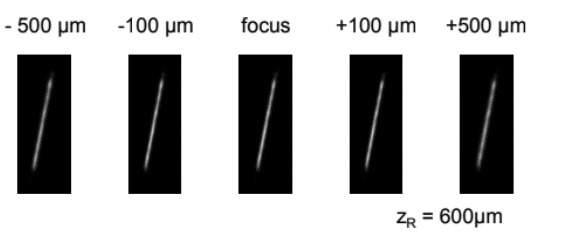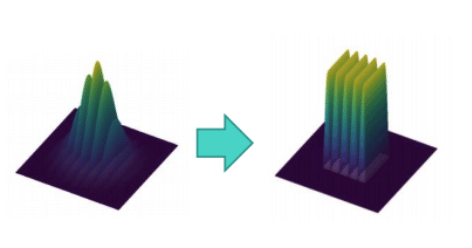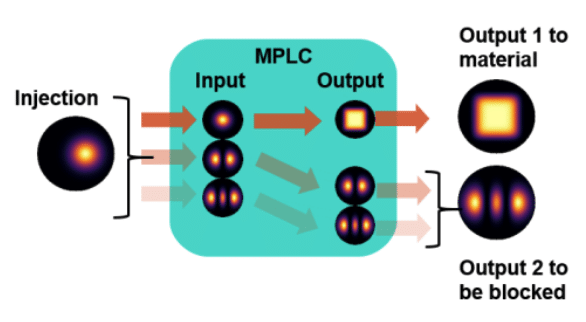Laser Beam Shaping
Multi-Plane Light Conversion (MPLC): A unique technology

Discovered in 2010 in the Kastler Brossel Laboratory, a French research laboratory specializing in fundamental physics of quantum systems, Multi-Plane Light Conversion (MPLC) was originally meant for multimode quantum optics. It is based on the succession of transverse phase profiles, similar to highly complex lenses, separated by a specific propagation distance. And because it “is a very low loss process,” MPLC can combine and shape multiple light beams. The passive nature of this technology means it can be integrated in systems where reliability is critical.
The Multi-Plane Light Conversion (MPLC) main characteristics are:
Free-form beam shaping through succession of spatial phase profiles and propagation
Passive beam shaping with no intrinsic loss
Reflective implementation, can handle high power / energy
Multiple beams can be shaped simultaneously
To learn more about MPLC, please watch the video below from CAILABS.
Using MPLC technology to improve ultrafast-laser based processes
 These laser material processes can benefit from MPLC by:
1. increasing overall quality by shaping the light (free-form shaping, diffraction limited shaping, preserving the depth of focus)
These laser material processes can benefit from MPLC by:
1. increasing overall quality by shaping the light (free-form shaping, diffraction limited shaping, preserving the depth of focus)
 2. increasing yield (optimal beam shaping, beam splitting, preserving the pulse duration
2. increasing yield (optimal beam shaping, beam splitting, preserving the pulse duration

MPLC vs. Adaptive Optics
Adaptive optics consists of reshaping the wavefront using a deformable mirror. Figure 1 shows a typical adaptive optics system. The incident signal is sent to the deformable mirror which corrects wavefront distortion. A fraction of the corrected signal is sent to a wavefront sensor to characterize its quality in real time. Finally, the other fraction of light is sent through the optical fiber to the telecommunication receiver. For this study, a wide-field photodiode was also used to measure the total intensity fluctuation of the wavefront in the focal plane. Figure 1: Diagram of a standard adaptive optics system
Although its function is similar, the approach of the TILBA-R is different. Its objective is not to actively compensate for wavefront distortion, but rather to collect all the light and passively convert it into usable modes. A light wave can be decomposed into modes. In this case, we have chosen Hermite-Gauss modes. The Mutli-Plane Light Conversion technology (MPLC) on which the TILBA-R is based, then collects these various disruptive modes and demultiplexes them into as many single-mode fibers. The dynamics of turbulence still exist, but they are reflected in variations in phase and intensity of the modes, which themselves are fixed. After demultiplexing, these variations result in changes in phase and intensity of the respective signals, but in the single-mode fibers.
This passive approach makes it possible to compensate for the phase shift in the fibers themselves rather than with mechanical elements, which are intrinsically limited in speed. Finally, it should be noted that if adaptive optics also use phase mode , such as Zernike polynomials in turbulence analysis. MPLC works on the complex field, i.e. both the phase and the amplitude.
Figure 1: Diagram of a standard adaptive optics system
Although its function is similar, the approach of the TILBA-R is different. Its objective is not to actively compensate for wavefront distortion, but rather to collect all the light and passively convert it into usable modes. A light wave can be decomposed into modes. In this case, we have chosen Hermite-Gauss modes. The Mutli-Plane Light Conversion technology (MPLC) on which the TILBA-R is based, then collects these various disruptive modes and demultiplexes them into as many single-mode fibers. The dynamics of turbulence still exist, but they are reflected in variations in phase and intensity of the modes, which themselves are fixed. After demultiplexing, these variations result in changes in phase and intensity of the respective signals, but in the single-mode fibers.
This passive approach makes it possible to compensate for the phase shift in the fibers themselves rather than with mechanical elements, which are intrinsically limited in speed. Finally, it should be noted that if adaptive optics also use phase mode , such as Zernike polynomials in turbulence analysis. MPLC works on the complex field, i.e. both the phase and the amplitude.

Using Bessel Beams to Observe Microscopic Objects
Bessel beams are “needles” of light formed by the interference of a laser beam with a conical-phase (Fig. 1). They have many applications in both research and industry. In particular, they are used for machining transparent materials, such as glass or sapphire, and to make smartphone screens and watch glasses. Their properties also make them particularly attractive for viewing incredibly small structures and observing biological phenomena that are invisible to the naked eye.- Depth of field
- Spatial resolution
- Damage to Samples
